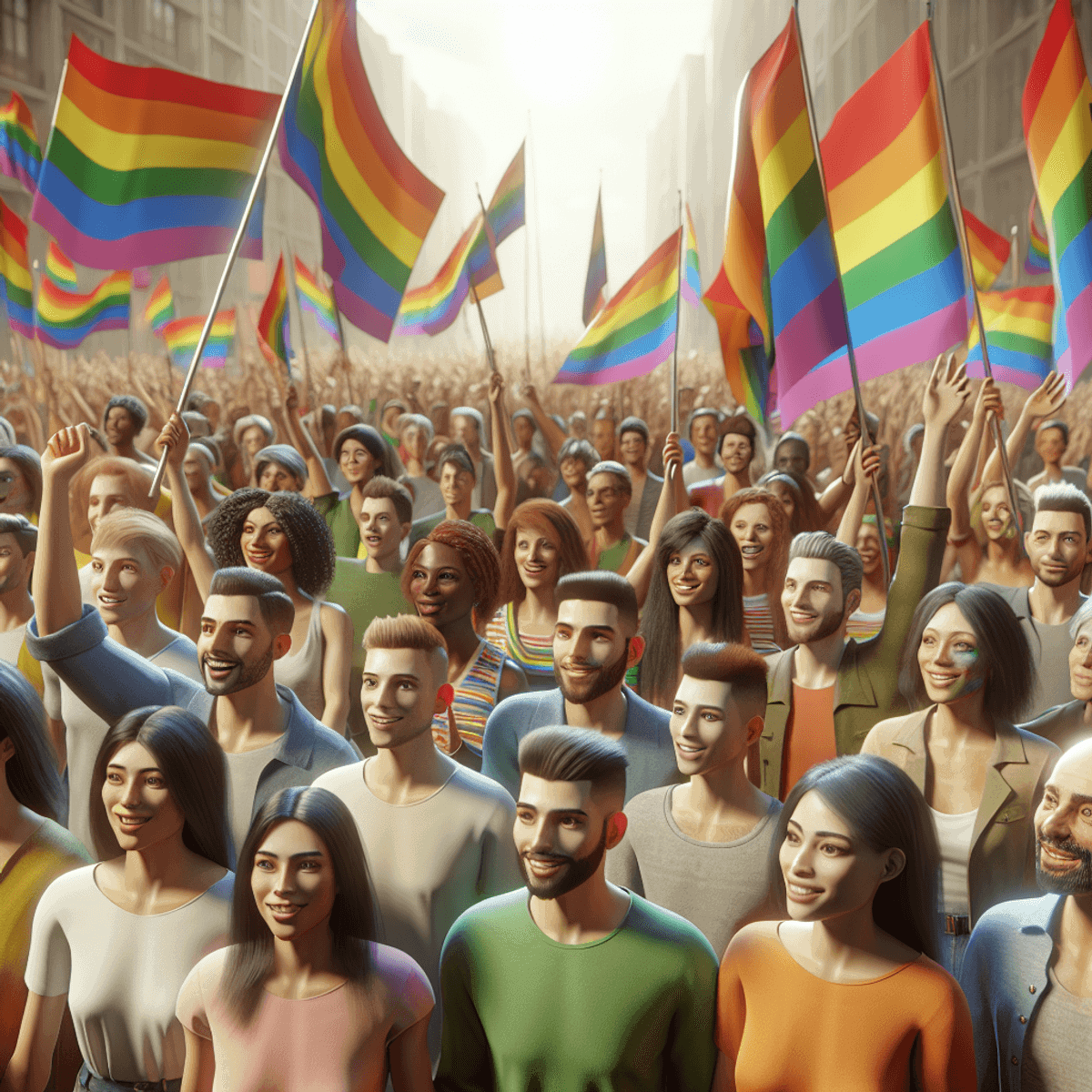National Coming Out Day (NCOD) is an annual event dedicated to promoting LGBTQ+ visibility and fostering acceptance within communities. Celebrated every year on October 11, this day holds historical significance as it marks the anniversary of the National March on Washington for Lesbian and Gay Rights in 1987. This pivotal march addressed pressing issues such as the AIDS crisis and discrimination against LGBTQ+ individuals.
NCOD was founded in 1988 by activists Robert Eichberg and Jean O’Leary with the mission to celebrate coming out as lesbian, gay, bisexual, transgender, or queer. The day encourages people to live openly and proudly, thereby challenging societal norms and reducing stigma.
This blog will explore:
- The origins and evolution of National Coming Out Day
- The significance of coming out for LGBTQ+ individuals
- Ways to celebrate NCOD within local communities
- Resources available for those considering coming out
- Criticisms and challenges associated with the concept of coming out
- The role of community support and advocacy beyond NCOD
Key takeaway: Understanding the various aspects of National Coming Out Day can help create a more inclusive environment not just on October 11 but throughout the year.
The Origins and Evolution of National Coming Out Day
National Coming Out Day (NCOD) was founded in 1988 by two pivotal figures in the LGBTQ+ rights movement: Robert Eichberg and Jean O’Leary. Both activists recognized the power of visibility in combating prejudice and inspiring change. Eichberg, a psychologist and founder of The Experience Workshops, and O’Leary, an openly lesbian political leader and former executive director of the National Gay Rights Advocates, aimed to create a day that would promote acceptance and visibility for LGBTQ+ individuals.
The inception of NCOD can be traced back to the 1987 National March on Washington for Lesbian and Gay Rights. This march, held on October 11, 1987, was one of the largest LGBTQ+ rights demonstrations at the time, bringing together hundreds of thousands of people who demanded equal rights and highlighted critical issues such as the AIDS crisis. The success and momentum from this event laid the foundation for NCOD. Eichberg and O’Leary chose the date to commemorate this historic march, emphasizing its significance in the ongoing fight for equality.
Initially observed in just 18 states, NCOD quickly gained traction due to its powerful message and grassroots support. By 1990, the Human Rights Campaign (HRC) had merged with NCOD, significantly bolstering its reach and resources. The HRC’s involvement helped to systematize annual themes that reflect contemporary issues facing the LGBTQ+ community, further embedding NCOD into public consciousness.
Evolution Over Time
Early Years
The initial observance of NCOD focused on local events such as rallies, workshops, and educational seminars aimed at encouraging individuals to come out. These activities provided a platform for sharing personal stories and fostering community solidarity.
Expansion
As awareness grew, so did participation. By the early 1990s, all 50 states were observing NCOD. International recognition followed suit with countries like Ireland, Switzerland, and the Netherlands joining in.
Digital Age
With the advent of social media and digital communication tools, NCOD expanded its reach even further. Online campaigns allowed for greater visibility and provided safe spaces for individuals to share their coming out stories anonymously or publicly.
Contemporary Observance
Today, NCOD is marked by a wide array of activities ranging from pride parades to educational panels. Schools, workplaces, and community organizations often host events that foster inclusivity and support.
The journey from a nascent idea sparked by a monumental march to a globally recognized event underscores NCOD’s enduring impact on promoting LGBTQ+ visibility. Through continuous evolution and adaptation, it serves as a testament to the strength of community activism in driving social change.
Exploring these origins offers valuable insight into how strategic advocacy can shape societal attitudes over time.
The Importance of Coming Out
Coming out is a deeply personal experience for many LGBTQ+ individuals. It represents the moment when they choose to reveal their sexual orientation or gender identity to others, often starting with family and close friends. This act is seen as an important step toward living authentically and embracing one’s true self.
The bravery of LGBTQ+ individuals who come out cannot be overstated. Many face significant risks, including:
- Fear of Discrimination: Societal prejudices and discriminatory practices remain prevalent in many areas. The fear of being judged or mistreated based on one’s sexual orientation or gender identity can be daunting.
- Rejection from Family and Friends: One of the most challenging aspects of coming out is the potential for rejection by loved ones. The possibility of strained relationships or complete estrangement adds emotional weight to the decision.
Despite these challenges, coming out is often seen as an act of courage and empowerment. It allows individuals to break free from the confines of secrecy and fosters a sense of community among those who share similar experiences. For many, it also serves as a political statement, challenging societal norms and advocating for broader acceptance.
The coming out experience varies widely from person to person. Some may find support and understanding, while others may encounter hostility and rejection. Resources such as support groups, online communities, and counseling services play a crucial role in assisting those navigating this journey.
In essence, coming out is not just about revealing one’s identity; it’s about reclaiming one’s life and asserting the right to exist openly and proudly. This act can pave the way for greater visibility and representation, ultimately contributing to a more inclusive society.
Celebrating LGBTQ+ Identity on National Coming Out Day
Celebrating LGBTQ+ identity on National Coming Out Day involves various activities that promote visibility and foster a sense of community. Local communities often organize events such as:
- Pride Parades: These vibrant and colorful parades are a hallmark of LGBTQ+ celebrations. They provide an opportunity for individuals to express their identities openly and proudly.
- Educational Events: Workshops, panel discussions, and seminars provide valuable information about LGBTQ+ issues, history, and rights. These events help to educate both the LGBTQ+ community and allies.
- Art Exhibitions: Showcasing artwork by LGBTQ+ artists can highlight the diversity and creativity within the community. Art can be a powerful medium for expressing identity and experiences.
- Social Gatherings: Community centers or local organizations might host social gatherings where people can meet, share their stories, and build supportive networks.
Using pride symbols such as rainbows during these celebrations is crucial for promoting visibility and representation. The rainbow flag, created by Gilbert Baker in 1978, is one of the most recognizable symbols of LGBTQ+ pride. It represents diversity within the LGBTQ+ community and serves as a symbol of hope and solidarity.
In addition to the rainbow flag, other symbols like the transgender pride flag or the bisexual pride flag can be used to represent different identities within the broader LGBTQ+ spectrum. Displaying these symbols during National Coming Out Day events helps to create an inclusive atmosphere where everyone feels seen and valued.
By participating in these activities and proudly displaying pride symbols, individuals not only celebrate their own identities but also contribute to raising awareness about LGBTQ+ issues. This collective action helps to combat stigma and discrimination, fostering a more inclusive society for all.
Resources for Individuals Considering Coming Out
For those contemplating coming out, having access to reliable resources can make a significant difference. The journey of coming out can be daunting, and being well-equipped with information and support is crucial.
Online Guides
One of the most accessible resources for LGBTQ+ individuals is online guides. Websites like the Human Rights Campaign (HRC) offer comprehensive guides on coming out. These resources cover various aspects:
- Understanding Your Identity: Helps individuals navigate their feelings and understand their own identity.
- Preparation Tips: Offers practical advice on how to plan your coming out conversation.
- Dealing with Reactions: Provides strategies for handling different types of responses from friends, family, and colleagues.
Support Hotlines
Sometimes, speaking to someone directly can provide immediate relief and guidance. Several organizations offer support hotlines:
- The Trevor Project: Specializes in crisis intervention and suicide prevention for LGBTQ+ youth. They offer a 24/7 hotline at 1-866-488-7386.
- LGBT National Help Center: Offers free confidential peer-support and local resources across the United States. Their hotline number is 1-888-843-4564.
Community Centers and Local Organizations
Local LGBTQ+ community centers often provide invaluable resources. These centers can offer:
- Support Groups: Safe spaces where individuals can share their experiences and get advice from peers.
- Counseling Services: Professional counseling to help navigate the emotional aspects of coming out.
Educational Materials
Books and articles also serve as great resources. Some recommended reads include:
- “Coming Out: An Act of Love” by Rob Eichberg
- “Out & About Campus: Personal Accounts by Lesbian, Gay, Bisexual & Transgender College Students” edited by Kim Howard and Annie Stevens
Online Forums and Social Media Groups
Online forums such as Reddit’s r/lgbt or Facebook groups dedicated to LGBTQ+ support can also be beneficial. These platforms allow you to connect with others who have similar experiences, providing both emotional support and practical advice.
By leveraging these resources, individuals considering coming out can feel more prepared and supported throughout their journey.
Criticism and Challenges Associated with Coming Out
The concept of coming out is often celebrated as a courageous step toward self-acceptance and societal recognition. However, it’s critical to acknowledge that this experience is not universal. For many marginalized individuals, coming out can present significant risks and barriers.
Risks for Marginalized Individuals
- Fear of Discrimination: Many LGBTQ+ individuals fear facing discrimination in various spheres of life, including employment, housing, and healthcare. This fear is more pronounced for marginalized communities.
- Cultural and Religious Barriers: People from conservative cultural or religious backgrounds may face severe ostracism or even violence upon coming out.
- Intersectionality: LGBTQ+ individuals who also belong to other marginalized groups (e.g., people of color, immigrants) often experience compounded discrimination.
Impact of Discrimination Laws
Existing discrimination laws continue to impact the rights and lives of LGBTQ+ individuals. While there have been strides toward equality, numerous gaps remain:
- Employment Discrimination: Despite progress, not all states in the U.S. have comprehensive laws protecting LGBTQ+ employees from discrimination.
- Healthcare Access: Transgender individuals frequently encounter barriers when seeking gender-affirming care, often facing insurance denials or lack of knowledgeable providers.
- Housing Stability: The lack of explicit protections against housing discrimination leaves many LGBTQ+ individuals vulnerable to eviction or denial of housing based on their sexual orientation or gender identity.
Areas Needing Progress
- Inclusive Legislation: There is a need for more inclusive federal and state-level legislation that explicitly protects LGBTQ+ rights in all areas, including education, public accommodations, and adoption services.
- Public Awareness Campaigns: Increasing public awareness through education can help reduce stigma and promote acceptance within society.
- Support Systems: Strengthening support systems such as community centers, hotlines, and online resources can provide crucial assistance to those contemplating coming out.
Criticism surrounding National Coming Out Day highlights the necessity for broader systemic change beyond individual acts of bravery. Addressing these ongoing challenges requires a multifaceted approach involving legal reforms, societal education, and robust support networks.
Community Support and Advocacy Beyond National Coming Out Day
Community support networks play a crucial role in helping LGBTQ+ individuals navigate their coming out journeys throughout the year, not just on National Coming Out Day (NCOD). These networks provide a safe space for individuals to share their experiences, receive emotional support, and gain practical advice. Whether through local LGBTQ+ centers, peer support groups, or online communities, these networks help foster a sense of belonging and acceptance.
1. Local LGBTQ+ Centers
Many cities have dedicated centers that offer resources such as counseling services, support groups, and educational workshops. These centers often host events and create opportunities for community building.
2. Peer Support Groups
Regular meetings with individuals who have similar experiences can be incredibly beneficial. These groups provide an environment where people can discuss their challenges and successes without fear of judgment.
3. Online Communities
Platforms like Reddit, Facebook groups, and specialized forums offer 24/7 support. These online spaces are particularly valuable for those who may not have access to local resources.
Beyond community support networks, several notable advocacy initiatives aim to advance LGBTQ+ rights throughout the year. These initiatives work on various fronts, from legal reforms to public awareness campaigns.
1. Human Rights Campaign (HRC)
HRC continues to be a leading force in promoting LGBTQ+ rights. They offer numerous resources for those considering coming out and work tirelessly on legislative advocacy to protect LGBTQ+ individuals against discrimination.
2. The Trevor Project
Known for its crisis intervention and suicide prevention services, The Trevor Project also engages in advocacy work to create safer environments for LGBTQ+ youth.
3. GLAAD (Gay & Lesbian Alliance Against Defamation)
GLAAD focuses on media representation. By holding media accountable and encouraging inclusive portrayals of LGBTQ+ individuals, GLAAD helps shape public perception and promotes acceptance.
These organizations and networks collectively contribute to a supportive environment that extends beyond NCOD. Their ongoing efforts ensure that the fight for equality and acceptance continues every day of the year.
Conclusion
Participating in National Coming Out Day is a significant step toward fostering inclusivity and supporting the ongoing journey for LGBTQ+ rights. Engaging with your local community can make a meaningful difference:
- Organize or join local events: Pride parades, educational workshops, and community gatherings can amplify LGBTQ+ voices.
- Support LGBTQ+ organizations: Volunteer your time or donate to groups that advocate for equality and provide resources.
- Use inclusive language and symbols: Incorporate pride symbols like rainbows in everyday life to promote visibility.
Encouraging year-round support ensures that the momentum created by National Coming Out Day continues to drive positive change. Your involvement is crucial in building a more inclusive and accepting society for everyone.















